Atypical, beautiful, and attention-grabbing, red butterflies may be a rare sight in some areas of the world.
They can also be a common sight in tropical and tropical rainforest climates where red butterflies may be active throughout the year.
Here are some of the most common butterflies with considerable or dominant red areas across the wings.
Table of Contents
1. Red Admiral
Mostly black, The Red Admiral (Vanessa atalanta) is one of the most common butterflies in the world. It additionally features a red band on its wings which contrasts its appearance.
Red Admiral butterflies are marked by either orange or red nuances as bands across their wings, depending on their age.
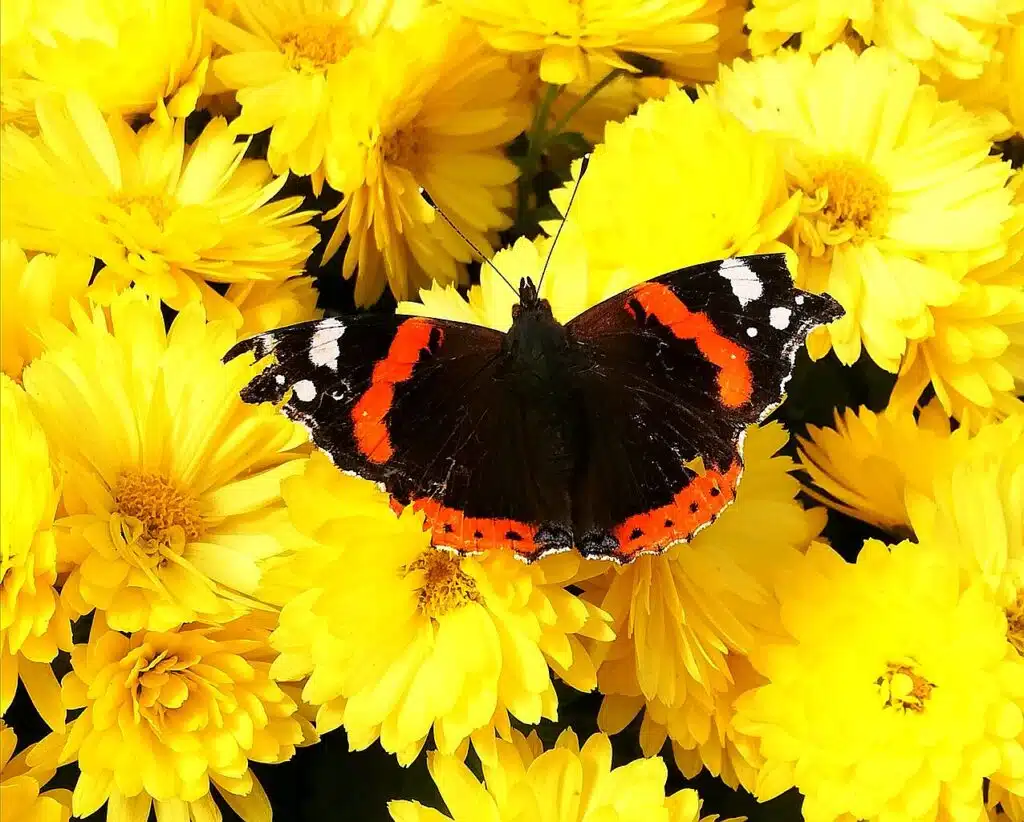
It shows a vivid red, known as vermilion red, band across the forewings and hindwings. These butterflies are additionally known for this rare red nuance on the wings.
Sitting somewhere between rust and vivid red, vermillion is among colors that may act as warning signals to predators as well as attraction cues when finding a mate.
But Red Admirals also have attractive ventral patterns. A combination of brown, black, white, and yellow patterns make up its ventral appearance.
Looking black and red on top and brown ventrally, this butterfly may even seem like a different species, depending on where it’s viewed from.
Once a mature adult, a Red Admiral butterfly also shows additional blue sections across the forewings.
Red nuances – vermilion
2. European Peacock Butterfly
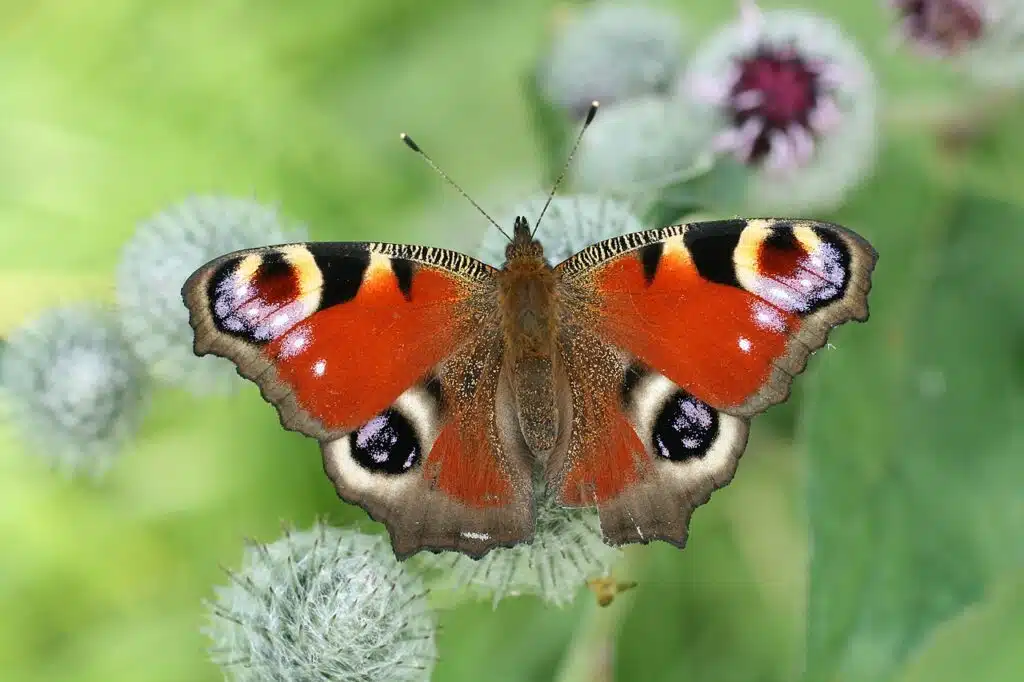
Like The Red Admiral, The European Peacock Butterfly (Aglais io) is one of the larger red butterflies in the world.
Its colors also vary, but it comes with significant red nuances across its body and wings.
The European Peacock Butterfly has red lower forewings. The upper part of the wings shows black and yellow eyespots.
Red nuances on its forewings vary from red-orange, red-brown, and rust-red.
Its hindwings show a similar pattern of upper eyespots and lower all-red sections.
In fact, this species may even look, unlike a butterfly due to its 4 large eyespots.
Its ventral side shows a wood-like pattern of brown and black colors which improve its camouflage. This butterfly only shows its eyespots and true colors with its open wings.
Red nuances – rust-red, red-orange, red-brown
3. Red Peacock

Mostly red nuances are specific to Red Peacocks (Anartia amathea). The red nuance as well as the red color percentage on the wings depends on the gender and the location of this species.
Red Peacocks are found in South America and the Southern range of Central America.
Some of the butterflies in Suriname and Tobago are known for having the most significant red nuances across the wings.
If females are mostly brown, male Red Peacocks are mostly red, with wide black margins across the forewings and hindwings.
A range of tiny white spots further decorate the outer area of their wings, particularly of the forewings.
Lesser red areas may be seen on Red Peacocks in Venezuela and other regions of South America.
This butterfly additionally shows brown and yellow ventral colors in the case of the males which only resemble females on their ventral wings.
Red nuances – bright red
4. Red Postman
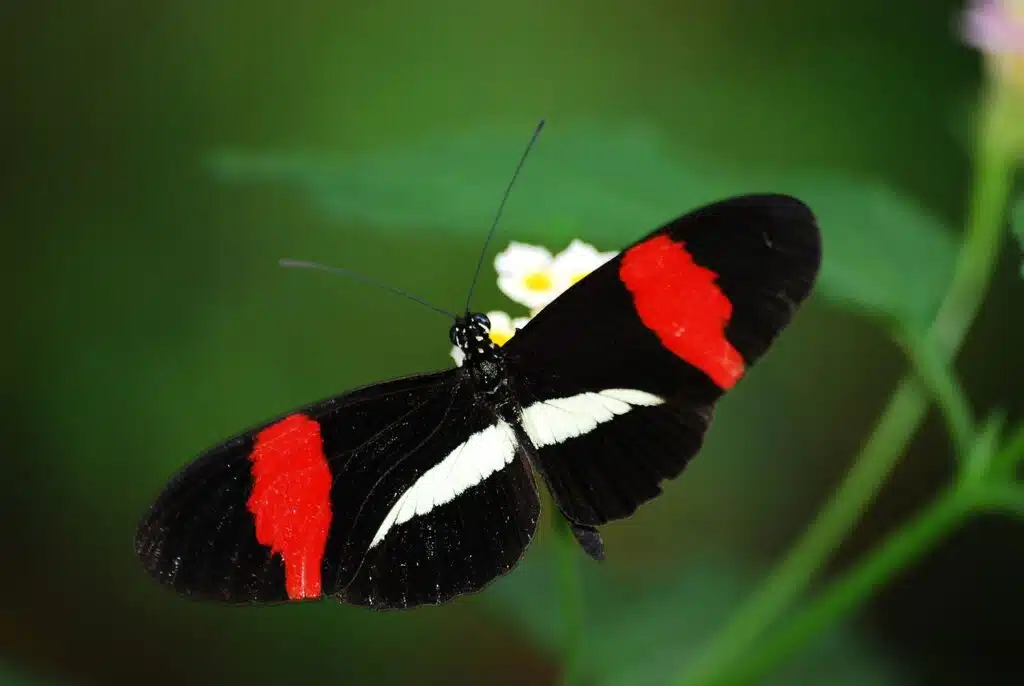
Somewhat similar to Red Admirals, Red Postmans (Heliconius erato) are also mostly black and red.
This is a butterfly species associated with passiflora plants but it can be found in widespread areas.
Males of the species are the ones with red bands across the wings while most of their forewings and hindwings are black, together with the body.
Females are also black but show pink or bright pink wing banding.
On the other hand, females may show tiny red ventral spots on the forewings. Males can be fully black with red bands or black with red and white bands.
Additionally, there are Red Postmans that only come in black and blue colors.
Even more color variation is specific to this species depending on its location. From all-black and red to black, red, white, and even red-free variants, there are more than 25 Red Postamn species around the world.
Red nuances – bright red, dark red, pink-red
5. Crimson Rose
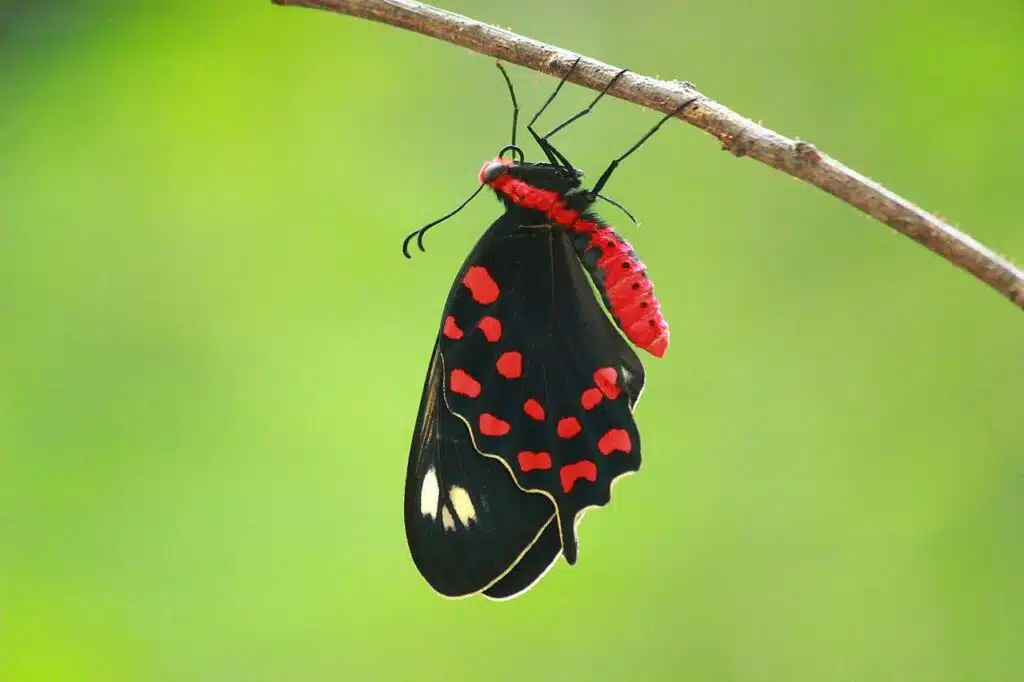
A species found across India and Sri Lanka, Crimson Rose (Pachliopta hector) is a species named after its crimson red nuance.
This species is not mostly red as it shows a base black color.
Some of the most common red areas on the butterfly include the spots on the lower hindwings.
This species has black forewings and black hindwings. White bands are distinguishable across its forewings.
Considerable large red areas are further seen on the ventral side of Crimson red butterflies.
For example, the body of the butterfly is mostly red ventrally.
Even more, its ventral wings also show large red spots similar to those on the dorsal wings.
With many red marks across the body, this butterfly has few natural predators due to its potentially dangerous appearance.
Red nuances – crimson
6. Red Rim
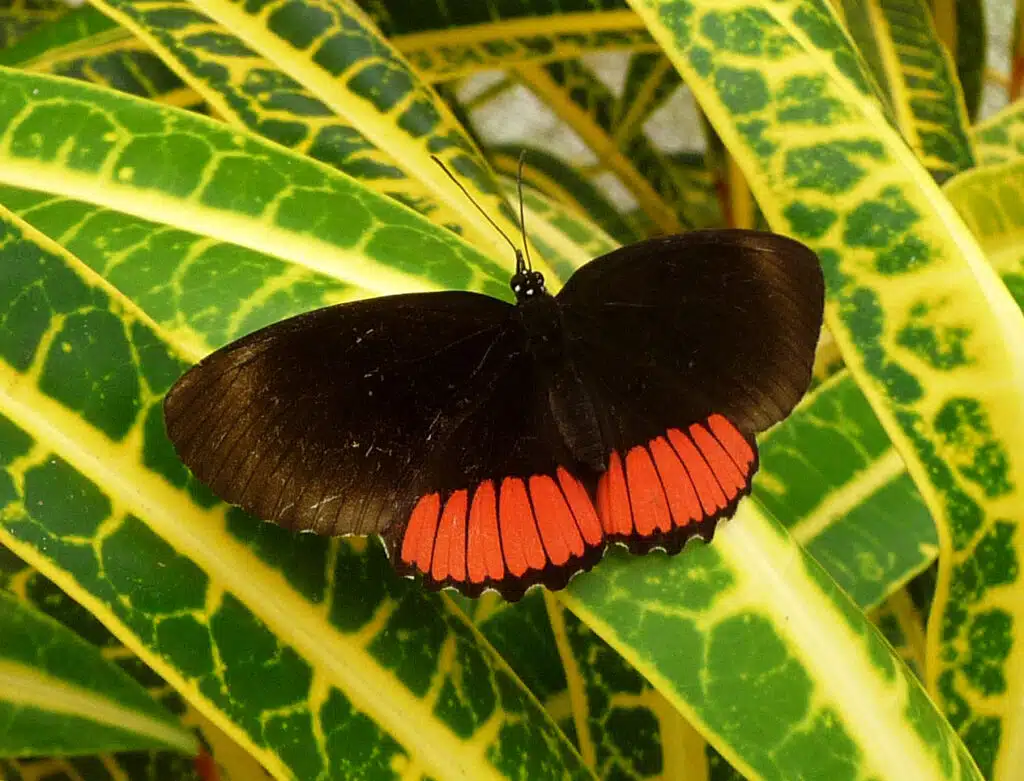
One of the Texas butterflies with considerable red patches is the Red Rim (Biblis hyperia). This is a species with a highly contrasting appearance.
Mostly seen in Mexico, this species that also live in Texas has a mostly black color across the forewings and hindwings.
Additional red bands are seen on its lower hindwings.
This is a continuous red band across the margins.
Growing to a maximum wingspan of around 3 inches, Red Rim butterflies are among the typical species to be avoided by predators as red is associated with a potentially poisonous species.
Red Rims are fans of rotting fruit and fruit, in general. These butterflies aren’t dependent on nectar for survival.
Red nuances – vivid red
7. Natal Acraea
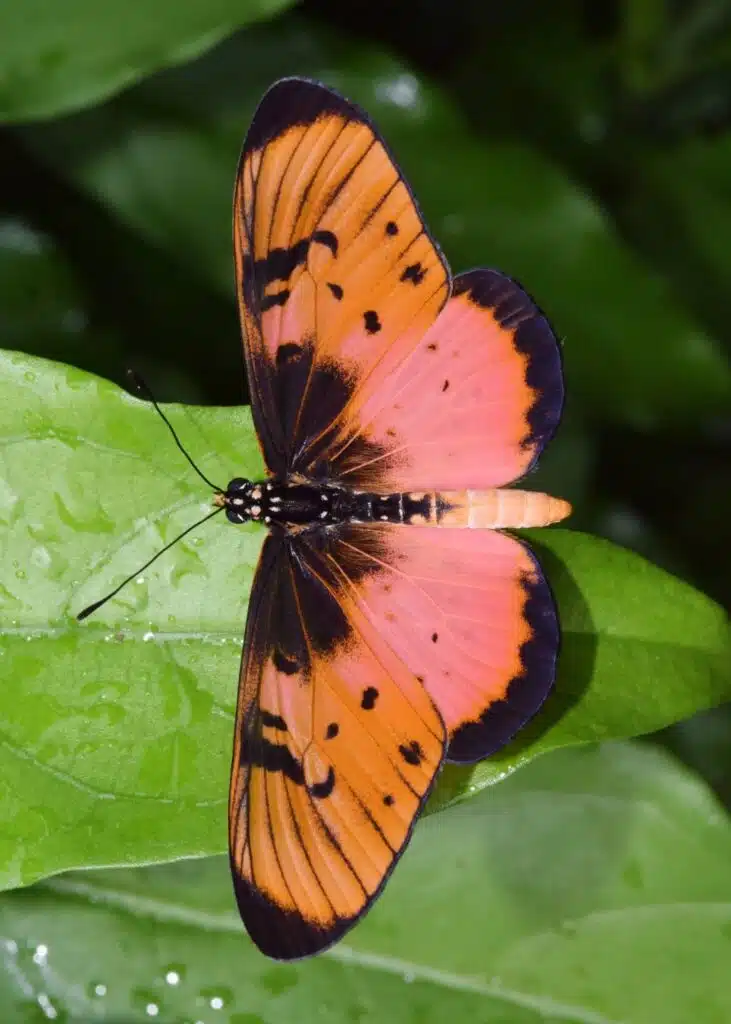
An African species with a long wingspan, these red butterflies (Acraea natalica) are active throughout the year.
A common sight in South Africa, the species regularly grows to a wingspan of over 3 inches.
Its coloring can vary slightly, depending on the season and subspecies.
Red nuances, particularly orange-red, are specific to this butterfly.
Natal Acraea is a species that has contrasting black margins, black spots, and black veins.
While its red nuance varies, this is a species that constantly has black and yellow margins with different shades of red specific to the inner parts of its wings.
This species also shows mostly yellow ventral wings with additional red spots and black veins.
Red nuances – red-orange, red-brown
8. Red Lacewing Butterfly
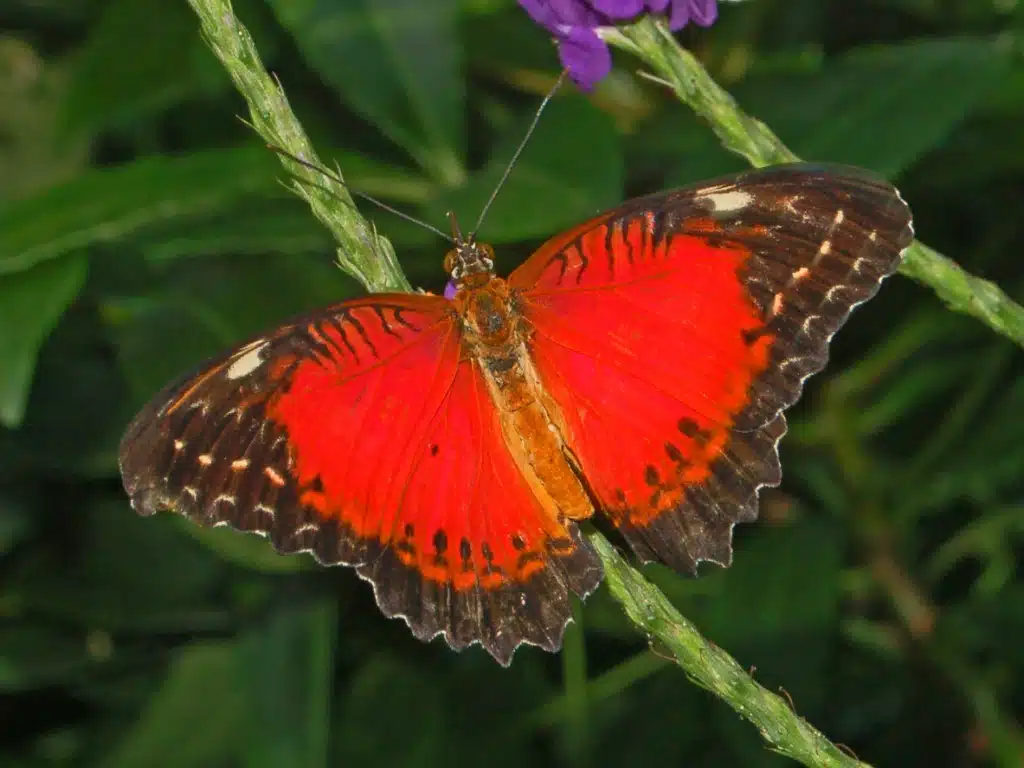
Present in Asia and Southeast Asia across different subspecies, Red Lacewing Butterflies (Cethosia biblis) can be mostly red or partly red.
Tens of subspecies are recognized for Red Lacewing Butterflies.
This is a genus with vivid red and uniform colors across the forewings and hindwings, with black spots and margins.
Red Lacewing Butterflies can also appear orange-red or even mostly orange dorsally.
While vivid red is specific to its dorsal wings, its ventral wings are mostly bright brown, orange, and white, in a juxtaposing pattern of bands.
Red Lacewing Butterflies in China can also show additional red bands on the ventral wings.
Red nuances – bright red, red-orange
9. Red-barred Amarynthis
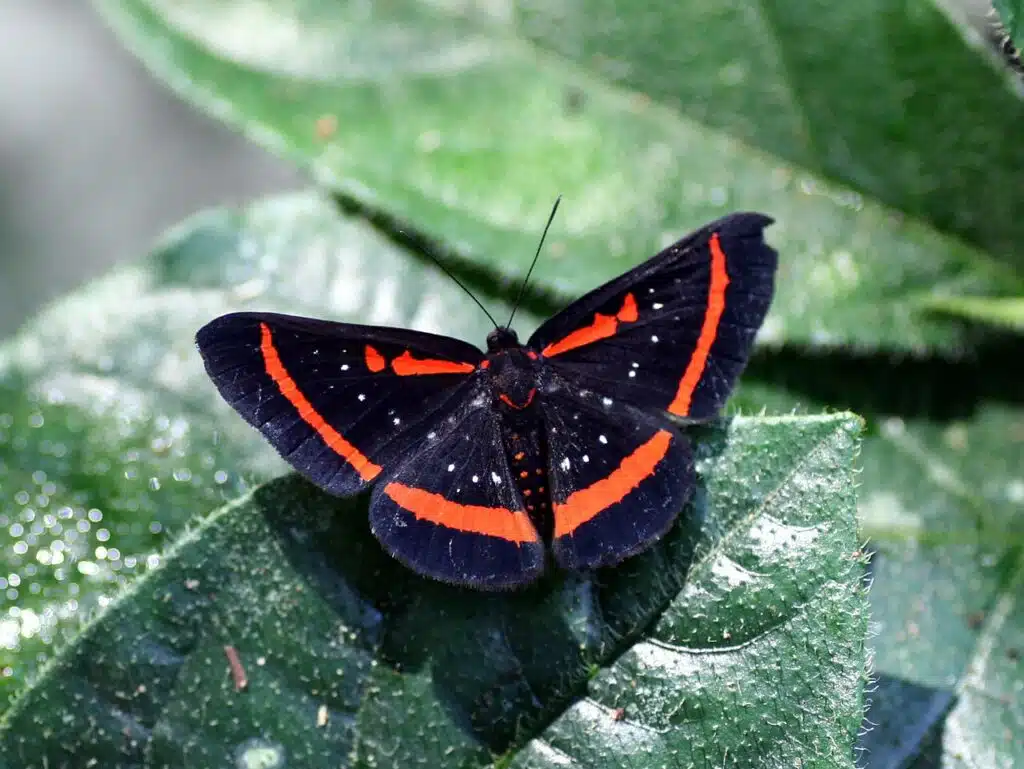
A species that only lives in rainforests, Red-barred Amarynthis butterflies (Amarynthis meneria) show considerable red sections across the wings.
While not mostly red, this black butterfly shows a combination of red bands and spots that contrast both its forewings and its hindwings.
Only found in low forests, this is a species with thin red bands on the upper forewings, and on the margins of its forewings and hindwings.
In addition, Red-barred Amarynthis butterflies also show red stripes along their black bodies.
White dots further contrast the black appearance of the butterfly, mostly on the outer forewings.
This species can be difficult to spot as it prefers to hide under tree leaves on sunny days.
Red nuances – bright red
10. Red Cracker
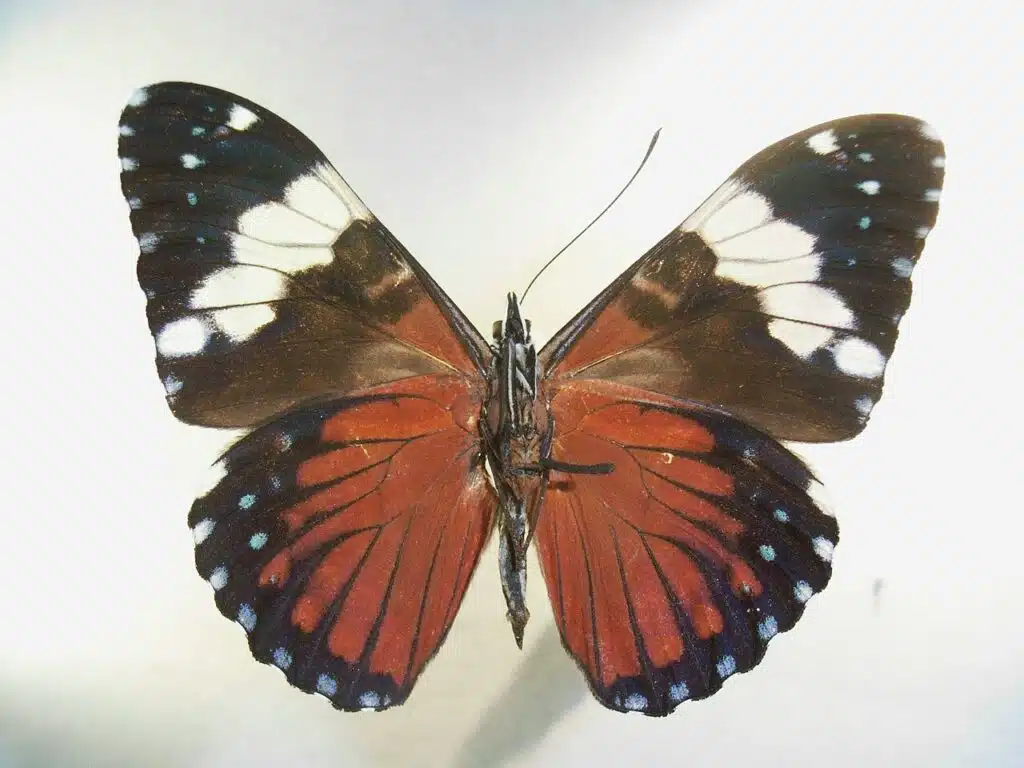
A South American species of humid habitat, Red Crackers (Hamadryas amphinome) are primarily known for making a cracking-like sound when flapping their wings.
At first, this species may not appear to show any red nuances.
However, Red Cracker’s ventral wings are mostly red while the dorsal wings show no red sections at all.
This is a species with bright red ventral wings which are only partly dark blue and white.
Its dorsal wings additionally show white, blue, and black wave patterns. Tan bands additionally mark its forewings.
Males of the species show white bands on the forewings while the females are most likely to show cream or tan contrasting bands.
Males are also more likely to show red ventral colors as opposed to orange-red ventral colors spotted on most females.
Red nuances – bright red
11. Red Satyr

A North American species, Red Satyr butterflies (Cissia rubricata) have representative chestnut-red nuances and multiple eyespots that stand out.
These types of butterflies have specific colors seen both on males and females, both dorsally and ventrally based on red nuances.
A common male Red Satyr has brown-red or chestnut-red inner wings coloring. The outer wings are normally dull brown.
They feature large eyespots on each forewing and 1-2 smaller eyespots on each hindwing, depending on the specimen.
In rare cases, Red Satyrs have no chestnut-red color but rather yellow or mustard colors dominating their forewings.
All Red Satyr Specimen show at least 4 large eyespots. These can help them to appear more threatening to birds and other predators.
Red nuances – chestnut-red
12. Red Tip
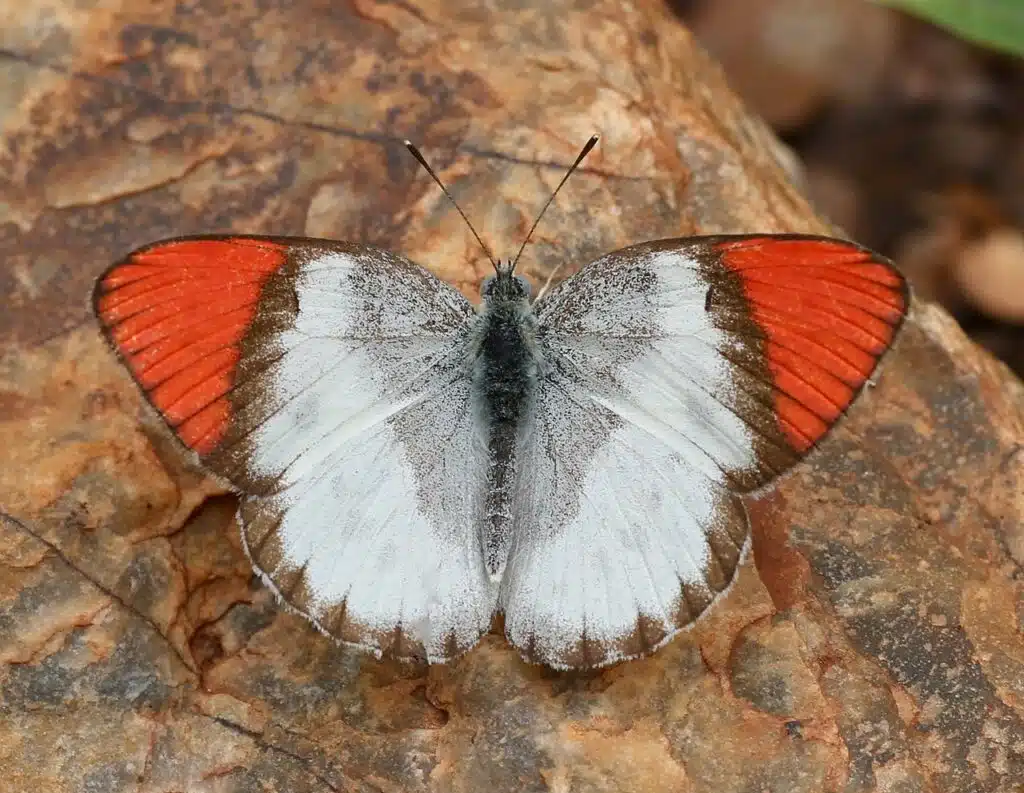
A species of East Africa and Asia, Red Tip butterflies (Colotis danae) are known for their vivid red forewing’ tips.
Only the females show this vivid color of the forewings. While even females can be highly variable in color, males are not mostly red on the forewing tips.
The male, even if red, has smaller red areas on the forewings compared to the female.
Both male and female Red Tips are mostly white. The Pearl white coloring of the wings means these butterflies are very bright in the sun.
Some females additionally show black spots across the red and black sections while others may even come with black margins across the forewings and hindwings.
Males, on the other hand, are commonly white and yellow or white and orange, lacking the more vivid red nuances seen in females.
From Angola to India, this species can be highly variable with some specimens being even brown-dominant.
Red nuances – bright red, orange-red,
13. Common Red Flash
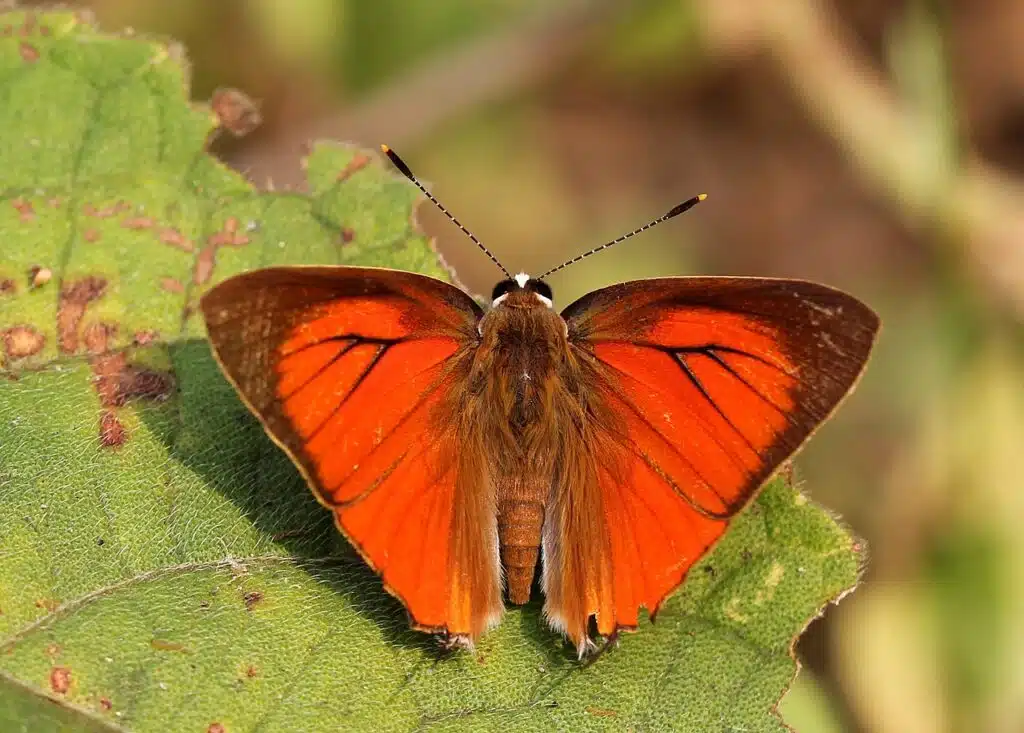
From orange-red to bright red, Common Red Flash butterflies (Rapala iarbus) are among the common species of India.
This is a butterfly dominated by red nuances, even as its name implies.
It features red sections on the inner forewings and hindwings.
These are uniform sections with little to no patterns apart from the visible veins.
Brown and dark brown margins are mostly specific to Common Red Flash butterflies.
This is a species that additionally comes in a few different other red nuances, closer to orange or brown.
All follow the same pattern of brighter inner wings with darker margins across the forewings and hindwings.
Red nuances – bright red, orange-red
14. Malay Red Harlequin
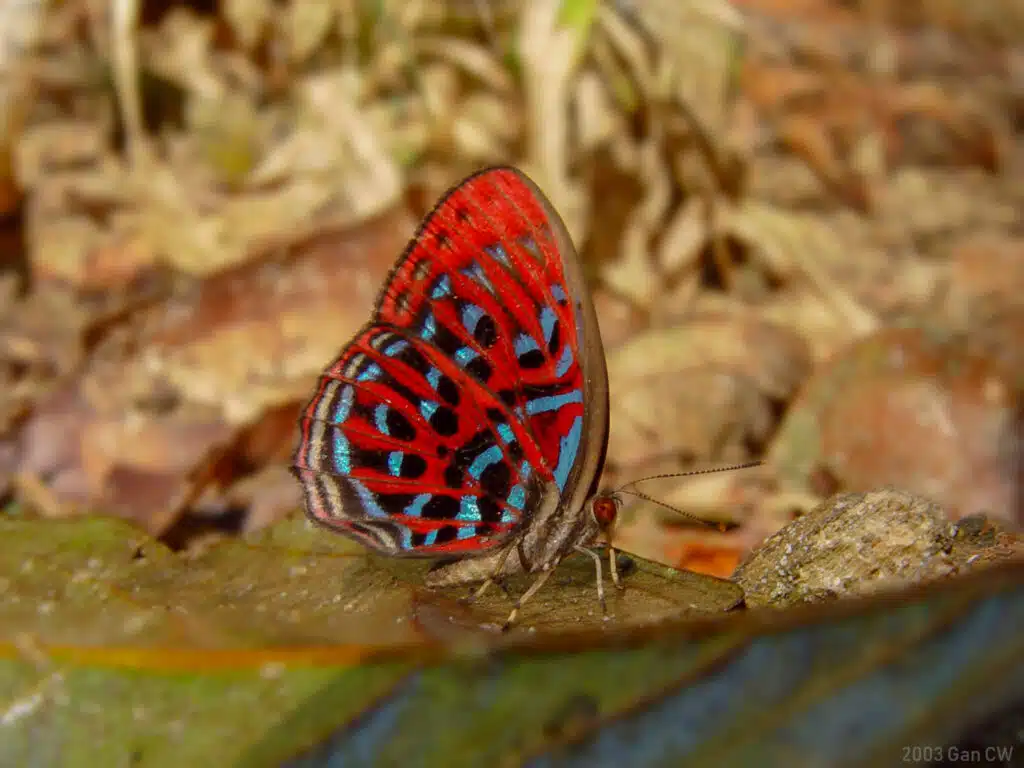
Native to Malaysia, this species of butterfly (Paralaxita damajanti) is red-dominant. While its main red nuance is variable, it still covers a good part of its wings.
The wings of the species are either bright red or pink-red as base colors.
They are also blue and black, in an alternating pattern of stripes, bands, and dots.
Much of the appearance of this species dorsally is also replicated ventrally.
Some variants of this species come with mostly red forewings and hindwings dorsally. A lesser number of butterflies show only red tips dorsally while brown dominates their ventral color.
All of these specimens are at least partially if not mostly red.
Also known as The Jungle Dragon, The Malay Red Harlequin may additionally feature a yellow spot on its dorsal wing tips.
Red nuances – bright red, pink-red
15. Eastern Red Lacewing Butterfly
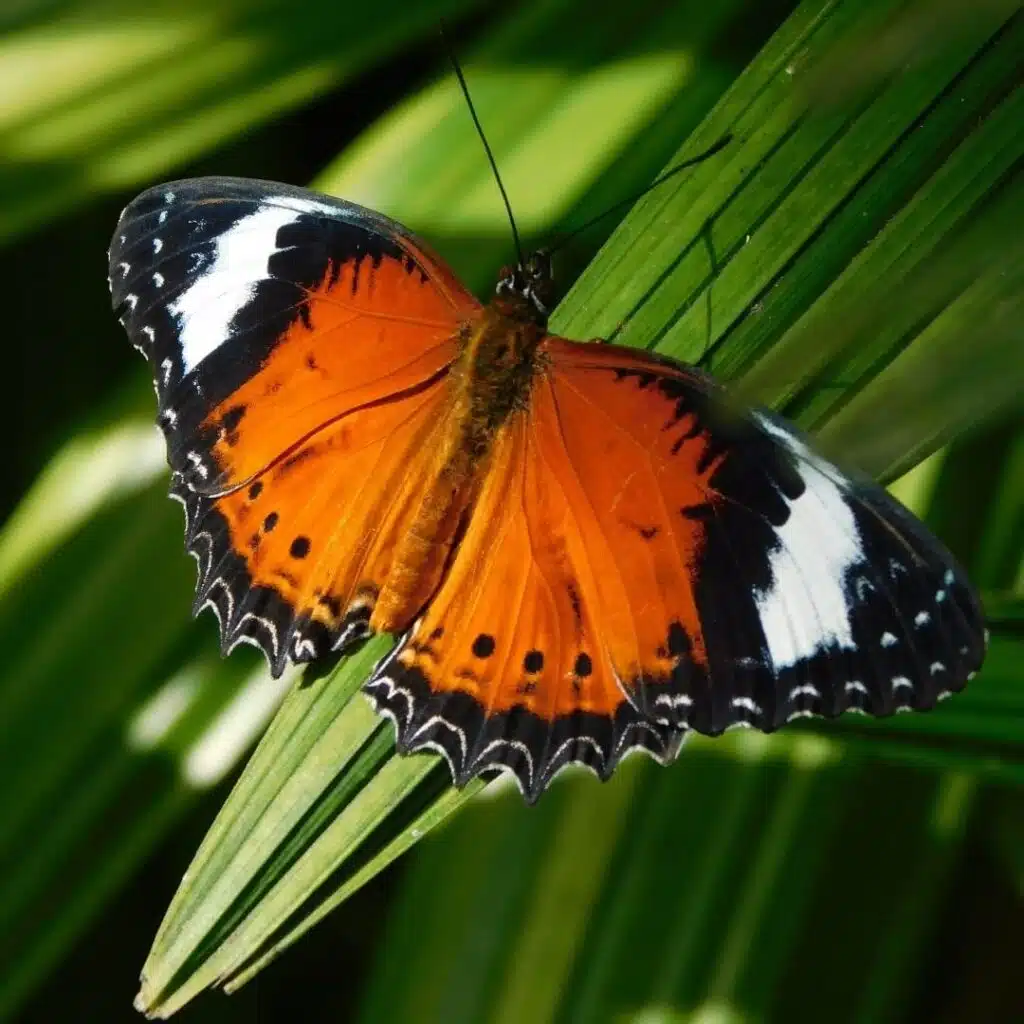
Mostly red, Eastern Red Lacewing Butterflies (Cethosia cydippe) inhabit a wide territory between Queensland in Australia and Indonesia.
These butterflies show a red-brown nuance across both the forewings and the hindwings.
This bright nuance dominates the inner wings of the species but is not fully uniform on the hindwings.
Small black spots are seen on the lower side of its hindwings.
This is also a species with wide white bands across its forewing tips. Wide black margins further add contrast to its dorsal appearance.
Only the body of the butterfly is yellow, as are the eggs laid by females on host plants.
Red nuances – red-brown
16. Flamingo Leafwing
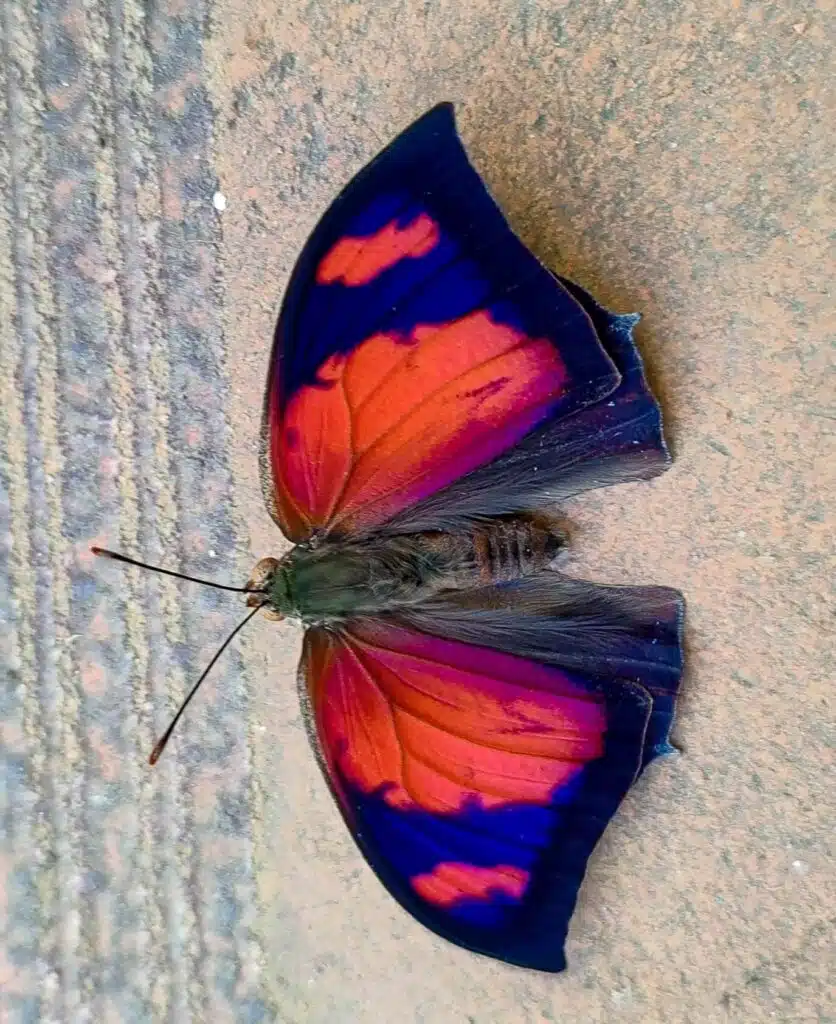
Some of the most interesting red nuances on butterflies are seen on Flamingo Leafwing (Fountainea ryphea).
Named after its leaf-like shape, this type of butterfly has a red-brown main color with red and purple overlays.
Its complete gradient of colors is only distinguishable in full sin.
In addition, this type of butterfly also shows black margins and black patterns across its wing tips.
Females are generally not as colorful as males and closer to brown.
The ventral wings of this species show an almost uniform dark brown color that further makes the species resemble a dead leaf.
A species of the neotropics, Flamingo Leafwings may even hang upside down on tree branches to look more like a dead leaf than a butterfly.
Red nuances – red-brown, red-to-purple, rust-red
17. Blood-red Glider
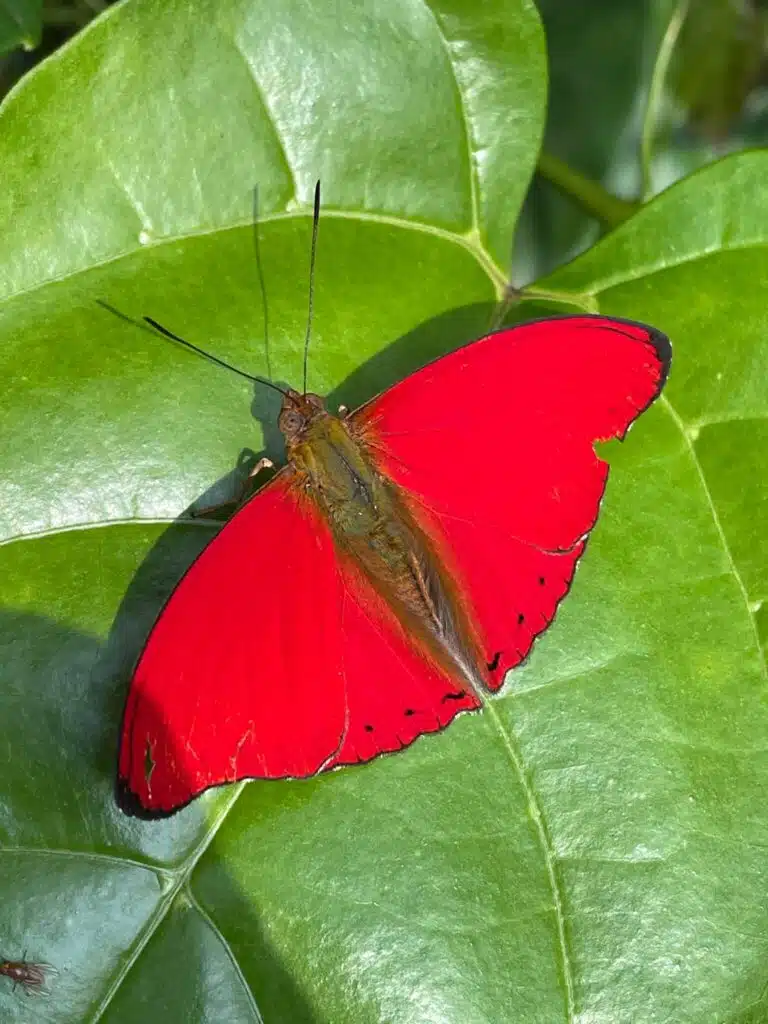
Blood-red Gliders (Cymothoe sangaris) are among the reddest butterflies in the world. Dominated by blood-red nuances, these types of butterflies have almost uniform coloring on the dorsal wings.
As their name implies, this is a vivid red nuance that’s impossible to overlook.
The ventral appearance of the species is dominated by various shades of dull brown, by contrast.
Some fine patterns may also be distinguished on the dorsal wings of the female. Tiny black dots are seen on the lower hindwings.
There’s even a fine black margin on the upper forewings of the female as well.
Native to Africa, this is a butterfly species that sometimes shows additional brown bands on the inner hindwings, closer to the body.
Red nuances – blood red
18. Red Flasher
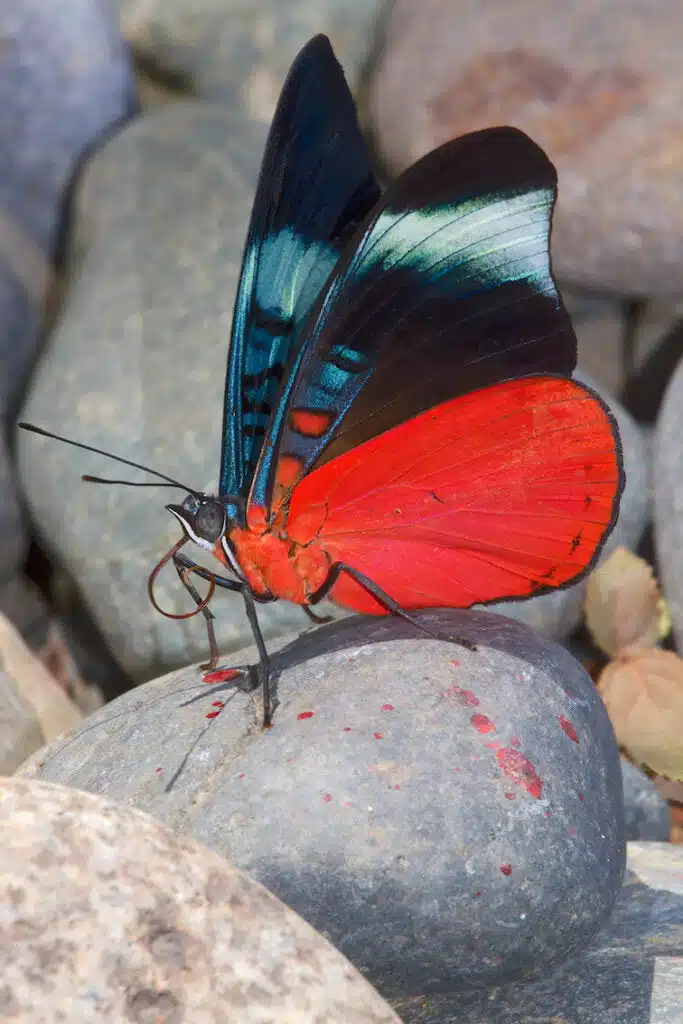
Partly blue, partly red, and partly white, The Red Flasher (Panacea prola) is named after its red ventral wings which are flashed or shown when its wings are in a resting position.
This is a butterfly with blue and bright wavy blue nuances dorsally. It even shows white wave patterns.
Its ventral forewings are red, on the other hand.
The uniform red coloring is seen on this part of the wings which may act as a warning sign to some of its predators.
Female Red Flashers show additional red sections on the dorsal hindwings.
A species found at medium and high elevations in South America, Red Flashers grow to a maximum wingspan of around 3 inches.
They are mostly found along The Andes Mountains.
Red nuances – bright red
19. Bloodred Acraea

Slightly smaller and slightly darker than Red Flashers, Bloodred Acraeas (Acraea petraea) are also mostly red.
This is a species with vivid red or bright red nuances across the dorsal wings.
Both the forewings and hindwings of the species are red with visible black veins and black margins across the wings.
Butterflies of the species additionally show red and black bodies.
Some nuance variations are seen on these butterflies which may appear brighter red on the inner wings towards the body.
As a species that grows to a maximum wingspan of just over 2 inches, Bloored Acraeas are mostly found in Africa.
Natives to Mozambique, these butterflies are active throughout the year with peak activity in April and May.
Red nuances – blood red
20. Clear-spotted Acraea
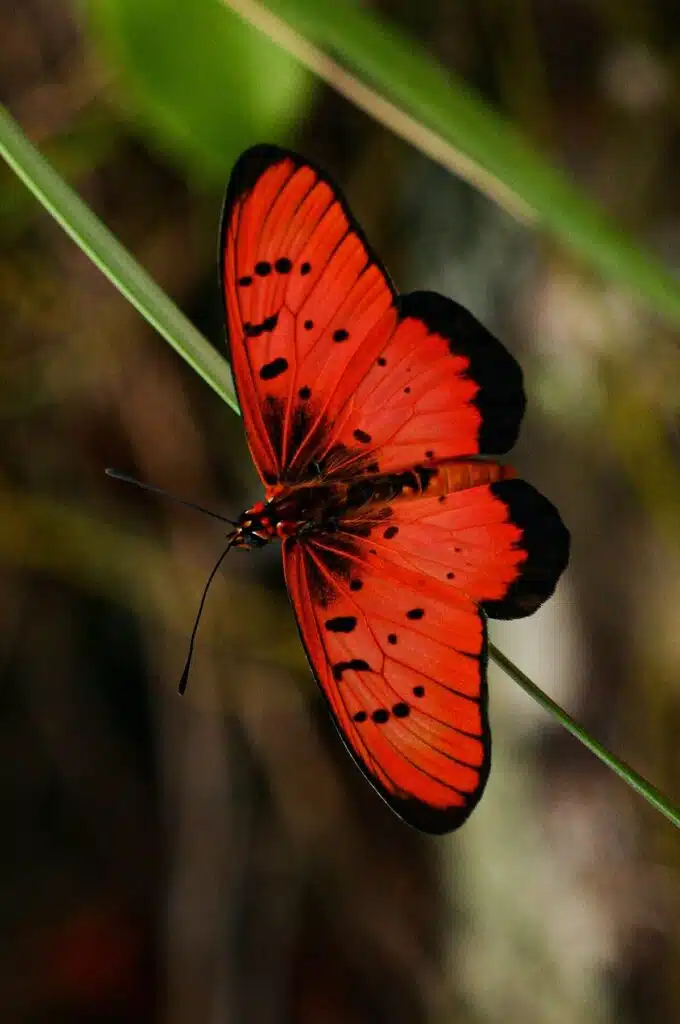
Red-yellow nuances are visible on The Clear-spotted Acraea (Acraea aglaonice).
This is a butterfly species with red nuances on its inner wings and gradient red-yellow nuances on its outer wings.
Black veins and margins further contrast its colorful appearance.
Rust-red nuances are specific to its ventral wings which additionally show white and black patterns and veins.
The body of the butterfly is black closer to the head and yellow towards the rear end.
Feeding on plant nectar, Clear-spotted Acraeas are some of the most important local butterfly species by number in countries such as Zimbabwe.
Butterflies of the species are active throughout the year.
Red nuances – red-yellow
21. Light Red Acraea
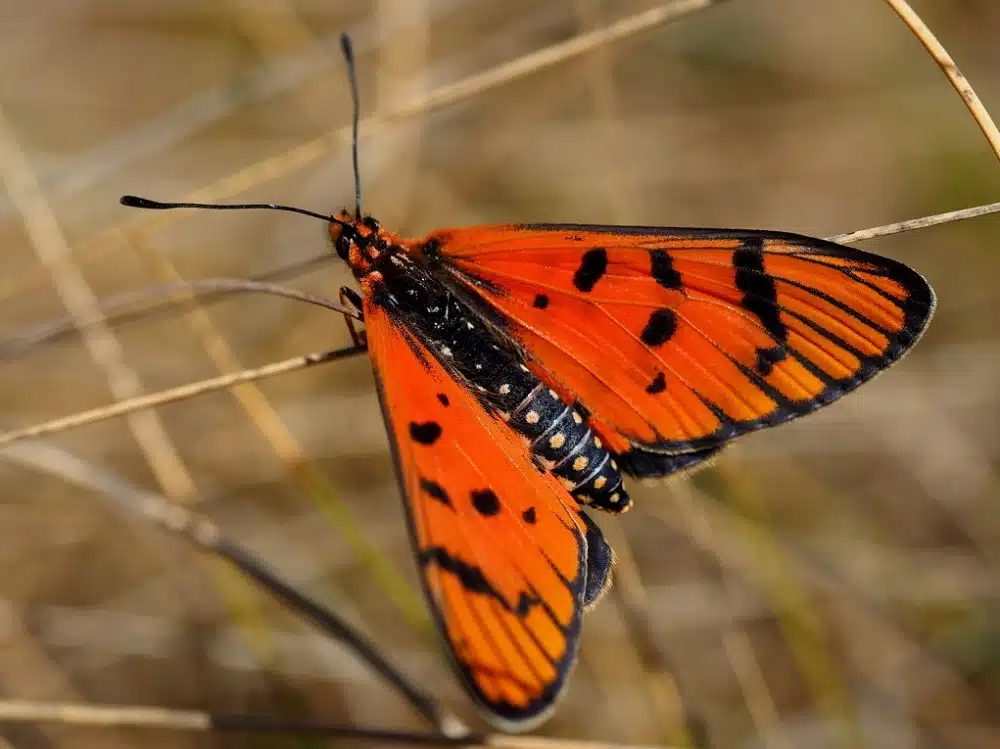
Also, native to Zimbabwe and other countries in Africa, Light Red Acraeas (Acraea nohara) are known for their varying shades of red.
Bright red, red-to-yellow, and red-orange nuances are seen across its dorsal wings.
These butterflies are dominated by red nuances in the central section of the wings where the red nuance is the most intense.
Black spots and margins further add contrast to this butterfly which is seen in multiple broods per year.
Its caterpillars lack red nuances as they are dominated by yellow and black nuances with an additional green stripe on the dorsum in the final instar.
Red nuances – bright red
22. Fiery Acraea
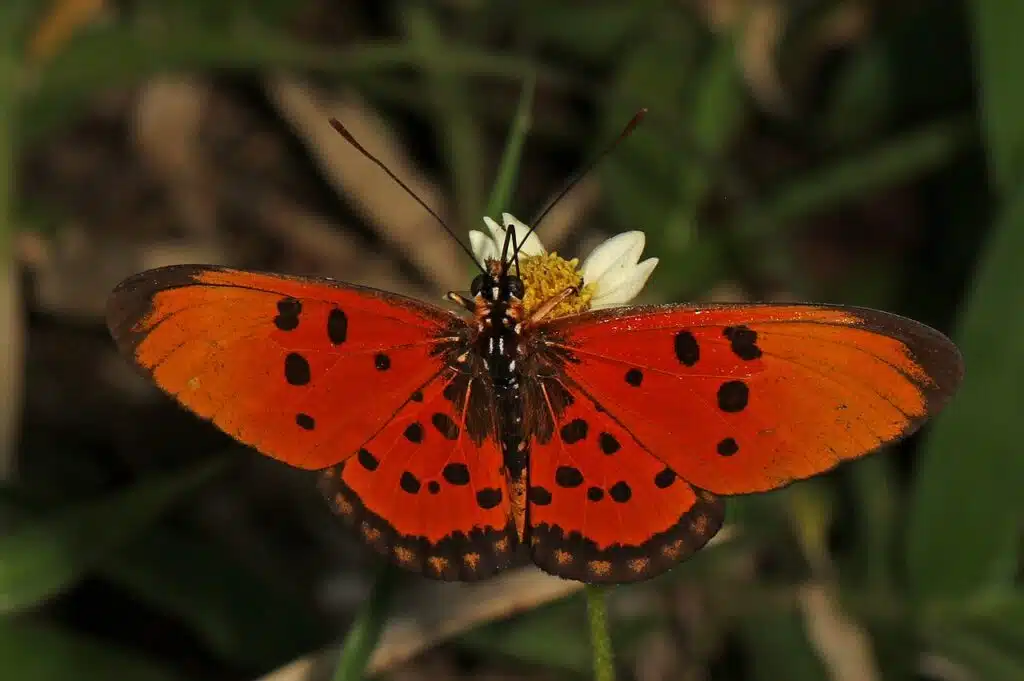
Native to countries of South Africa, Fiery Acraeas (Acraea acrita) are also red and spotted feeding on different types of passionflower.
A wide variety of red and yellow nuances are seen in a gradient across the wings of this species.
These butterflies can have darker red nuances on the inner or outer parts of the wings.
The number, shape, and size of the contrasting black marks on the wings are also highly variable.
Black marks can be present in high numbers or completely absent from the forewings and hindwings of these butterflies.
Found in tens of specimen, this butterfly is sometimes seen in yellow and black nuances, without any red marks or sections.
Red nuances – orange-red
23. Scarlet Acraea
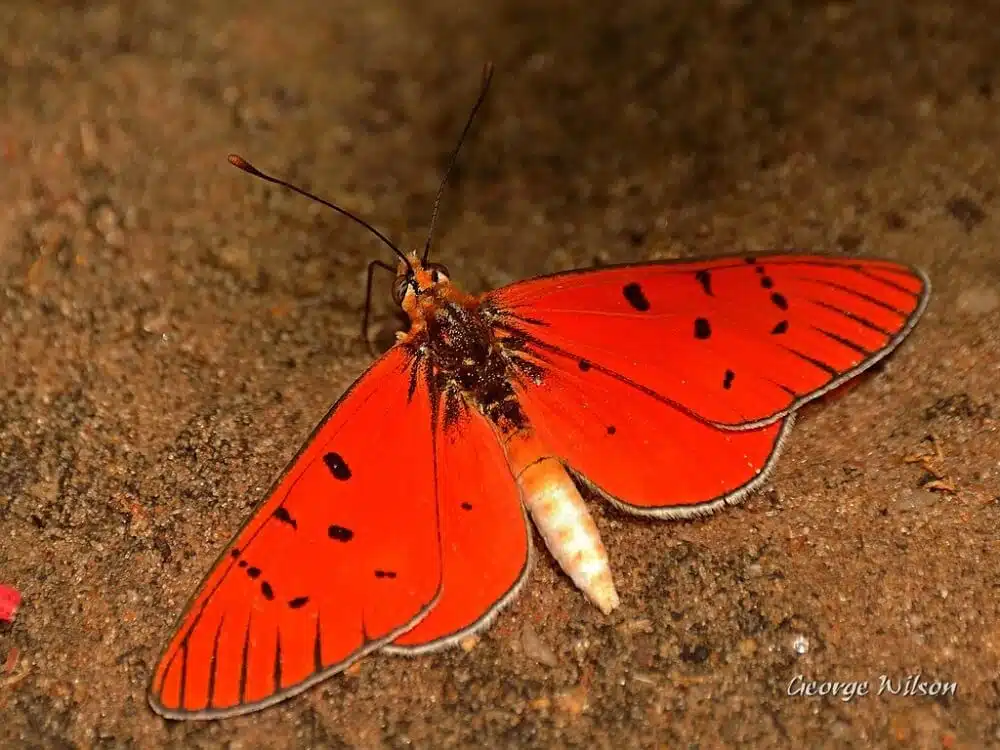
Scarlet Acraeas (Acraea atolmis) are also native to Africa. Similar to Light Red Acreaeas, these types of butterflies have a scarlet-orange nuance.
The red base nuance is seen across the wings with reduced yellow sections compared to other Acraea species butterflies.
This African native comes with black veins and tiny black spots between the veins both on the forewings and on the hindwings.
All of its variants come with some degree of yellow sections across the wings except its most common morph.
Like most butterflies of its species, Scarlet Acraeas are active almost throughout the year.
Red nuances – scarlet red
24. Small Flambeau

A species of Central and South America, Small Flambeaus (Eueides aliphera) start life as yellow eggs that turn into yellow and black caterpillars.
This is a species that then turns into a yellow, orange, and eventually red butterfly as it ages.
Small Flambeaus become vivid red with wide black margins and bodies that remain yellow.
Females are slightly brighter than males, with yellow or orange-red dominant nuances.
Yellow and yellow-brown nuances are specific to the ventral side of the butterfly.
Red nuances – yellow-red, orange-red, vivid red
25. Eastern Scarlet
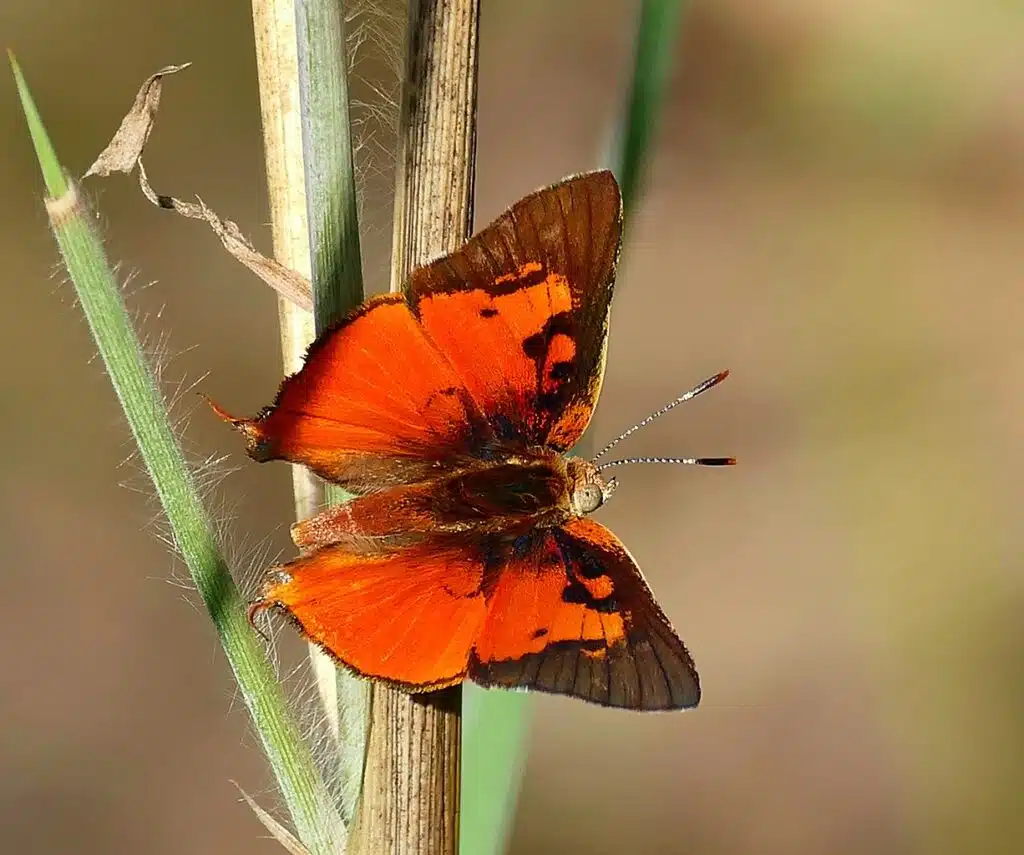
A species with nuance differences between males and females, Eastern Scarlets (Axiocerses tjoane) can be mostly red.
Males of the species have a scarlet red nuance, with additional black sections on the margins of the wings.
While still colorful, females are mostly orange.
Acacia-feeders, Eastern Scarlets are mostly red-brown across the lower forewings and the hindwings. Black is specific to the upper forewings.
Ventral coloring also shows red-brown coloring with additional white spots.
This species is native to Central and Southern Africa where it is active throughout the year.
Red nuances – red-brown
26. Red Mapwing

A species of Central and South America, Red Mapwing butterflies (Hypanartia kefersteini) have a dark red-brown nuance.
With more than 10 subspecies, Red Mapwings may also come in other colors such as orange-red.
Its hindwings are entirely dark red while its forewings are only partly dark red on the lower side as they feature black tips with white spots.
Red Mapwings have brown and black leaf-like undersides with additional white spots on the margins of the wings.
Red nuances – red-orange, red-brown, red-purple, blood red, crimson
27. Red Copper
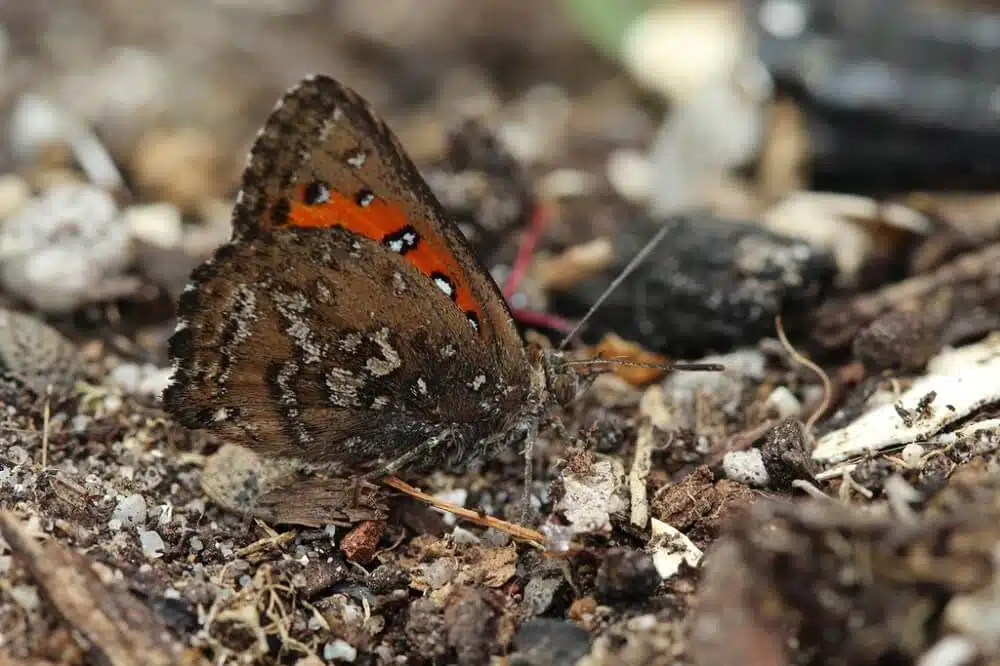
Red-brown nuances are specific to Red Coppers (Aloeides thyra).
Small types of butterflies are also known for having wide gray-brown margins.
Color variation is specific to the dorsal wings of the species but higher nuance variation is specific to the ventral wings of this butterfly.
While most are brown with black spots, the ventral wings of Red Coppers additionally feature red bands.
Some variants come with orange or yellow ventral bands, only visible with the wings in a resting position.
Red nuances – chestnut red, red-brown, orange-red
28. Bush Scarlet
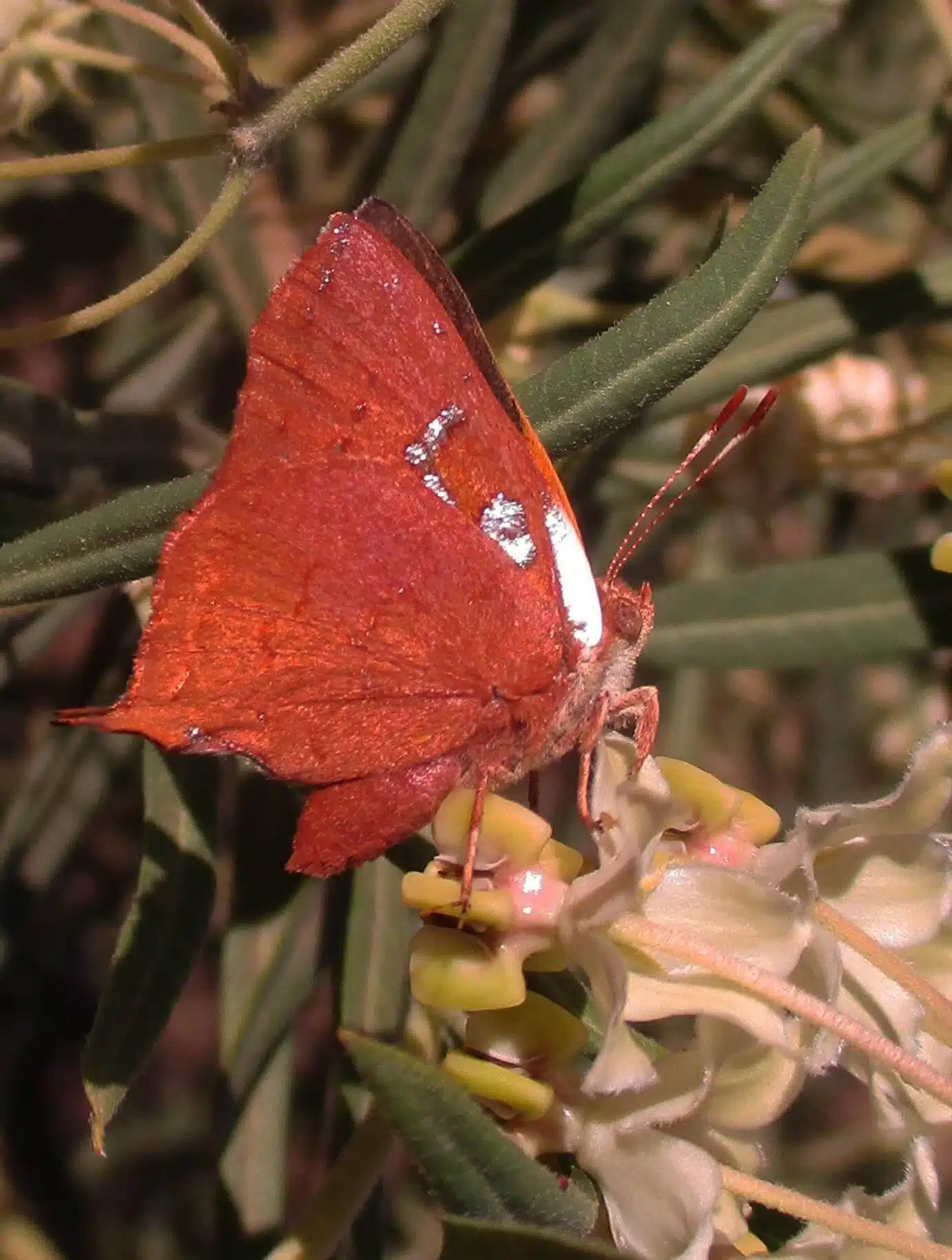
An acacia-feeding species, Bush Scarlets (Axiocerses amanga) are native to Africa.
These types of butterflies are dominated by dark red or red-brown nuances. The forewings are mostly red, with black margins and tips.
Red nuances cover the hindwings almost completely as well.
Some of its variants include yellow specimens and orange-red specimens.
All Bush Scarlet variants come with brown or dark brown ventral colors that make them look similar to leaves in a resting position.
Red nuances – blood red, red-brown, orange-red
29. Common Red Harlequin

Female Common Red Harlequins (Paralaxita telesia) are mostly red. Males are dull-colored and dominated by brown nuances.
The female Common Red Harlequin has red forewings and brown hindwings.
Red nuances are paired with azure and black spots on the ventral wings of the female.
A highly-contrasting appearance is also specific to the males of the species. They often have black ventral wings with orange-red tips and additional azure spots.
There are currently 4 recognized Common Red Harlequin subspecies.
These subspecies are natives of Southeast Asia.
Red nuances – dark red, red-brown, bright red